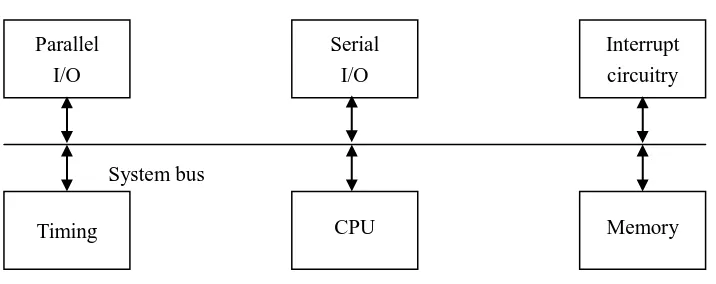UNIVERSITI TEKNIKAL MALAYSIA MELAKA FACULTY OF ELECTRICAL ENGINEERING
FINAL YEAR PROJECT REPORT
BEKU 4973
MICROPROCESSOR BASED DOT MATRIX LED DISPLAY SYSTEM FOR PEDESTRIAN LIGHT
NAME : HON YEEN SEONG
MATRIX NO : B 010510122
COURSE : POWER ELECTRONIC AND DRIVE (BEKE)
YEAR : 2008/2009
“I hereby that I have read through this report entitle “Microprocessor Based Dot
Matrix LED Display System for Pedestrian Light” and found that it has comply the
partial fulfillment for awarding the degree of Bachelor of Electrical Engineering (Power Electronic and Drive)”
MICROPROCESSOR BASED DOT MATRIX LED DISPLAY SYSTEM FOR PEDESTRIAN LIGHT
HON YEEN SEONG
This Report is Submitted In Partial Fulfillment of Requiremants For The Degree of Bachelor In Elctrical Engineering (Power Electronic and Drive)
Faculty of Electrical Engineering
UNIVERSITI TEKNIKAL MALAYSIA MELAKA
iii
I declare that this report entitle “Microprocessor Based Dot Matrix LED Display System for Pedestrian Light” is the result of my own research expect as cited in the references. The report has not been accepted for any degree and is not concurrently submitted in candidature of any other degree.
Signature : ………..
iv
v
ACKNOWLEDGEMENT
I would like to take this opportunity to thank a well experienced person, my supervisor, Prof. Madya Dr. Zulkifilie bin Ibrahim, who assist and guide me a lot in executing my project. He has opened my sights in a number of things through our conversations and I really do appreciate it. I would also like to thank both the panels for their guidance and advice.
vi
ABSTRACT
vii
ABSTRAK
viii
TABLE OF CONTENTS
CHAPTER TITLE PAGE
DECLARATION OF SUPERVISOR
PROJECT TITLE
DECLARATION OF STUDENT iii
DEDICATION iv
ACKNOWLEDGEMENT v
ABSTRACT vi
ABSTRAK vii
TABLE OF CONTENTS viii
LIST OF TABLES xi
LIST OF FIGURES xii
LIST OF ABBREVIATIONS xiv
LIST OF APPENDICES xv
1 INTRODUCTION 1
1.1 Introduction 1
1.2 Project Objectives 2
1.3 Scope of Project 2
1.4 Problem Statement 2
1.5 Project Schedule 3
1.6 Literature Review 4
1.6.1 Microprocessor Based System 4
1.6.2 Why use Microprocessor? 5
ix
1.6.4 Light Emitting Diode (LED) 7
1.6.5 Background of the Invention of LED Traffic 8 Light
1.6.6 Pedestrian Crossing 9
2 MATERIALS AND METHOD 12
2.1 Introduction 12
2.2 Hardware Parts 14
2.2.1 Rabbit Microprocessor, Rabbit 3000 14 2.2.1.1 Features and Specification of 15
Rabbit 3000
2.2.1.2 The CPU of Rabbit 3000 15 2.2.2 Rabbit Core Module, RCM 3100 17 2.2.3 Multi-Color Light Emitting Diode (LED) 20 2.2.4 4 to 16 Decoder / Demultiplexer 74HC154 21
2.2.5 Ultrasonic Motion Detector 22
2.3 Software Part 24
2.3.1 Dynamic C (Integrated Development System) 24 2.3.1.1 Initialization of Parallel I/O Ports 25
Using Dynamic C
2.4 Design and Development of Hardware Prototype Board 29
2.4.1 Circuit Design 29
2.4.1.1 LED Array Circuit 29
2.4.1.2 LED Driver Circuit 30
2.4.2 PCB Design 34
2.4.2.1 LED Array 35
2.4.2.2 LED Driver Circuit 36
x
2.5 Design and Development of Software 38
2.5.1 Sample of Source Code 38
2.6 Measuring and test equipments 41
2.6.1 Digital Multimeter 41
2.6.2 AC/DC Adapter 43
3 RESULTS 44
3.1 Overview of the LED Display Panel 44
3.1.1 LED Array Circuit 46
3.1.2 Ultrasonic Motion Detector 47
3.2 Displaying Animation 48
4 DICUSSION 49
4.1 Discussion 49
5 CONCLUSION 51
5.1 Conclusion 51
5.2 Recommendation 52
REFERENCES 53
APPENDIX A 54
APPENDIX B 64
APPENDIX C 67
APPENDIX D 70
APPENDIX E 72
xi
LIST OF TABLES
NO TITLE PAGE
1.1 Time Schedule. 3
1.2 Technical data for LEDs. 8
2.1 Specification of Multi-color LED. 21
2.2 Function Table of Decoder 74HC154. 31
xii
LIST OF FIGURES
NO TITLE PAGE
1.1 Block Diagram of a Microprocessor-Based System. 4
1.2 Types of LEDs. 7
2.1 Flow Chart of Project. 13
2.2 Rabbit 3000 in LQFP package. 14
2.3 Block Diagram of Rabbit 3000. 16
2.4 RCM3100 connector pinouts. 17
2.5 Subsystems of RCM3100. 18
2.6 RCM3100 prototyping board. 18
2.7 Multi-color LED. 20
2.8 74HC154. 21
2.9 Ultrasonic Motion Detector. 22
2.10 Crystal-lock Ultrasonic Motion Detector. 22
2.11 Signal at IC1. 23
2.12 Block diagram of parallel port initialization 26
2.13 Port initialization 28
2.14 LED Array Circuit Diagram. 29
2.15 LED Driver Circuit (GREEN Color). 30
2.16 LED Driver Circuit (RED Color). 30
2.17 Current Limiting Circuit Diagram. 32
2.18 Current limiting circuit. 32
2.19 Proteus Design Suite Software. 34
xiii
2.21 Bottom Side of LED Array PCB Layout. 36
2.22 LED Driver Circuit PCB Layout. 36
2.23 Sample of source code to turn ON led. 38
2.24 Sample of source code to flash LED repeatedly. 39 2.25 Sample of source code to flash two leds at different intervals. 40
2.26 Digital Multimeter. 41
2.27 AC/DC Adapter. 43
3.1 Front View of LED display panel. 44
3.2 Side View of LED Display Panel. 45
3.3 Back view of LED Display Panel. 45
3.4 LED Array Circuit. 46
3.5 LED Driver Circuit. 46
3.6 Ultrasonic Motion Detector. 47
3.7 Hardware setup. 48
3.8 Display of Red Stop Man Animation. 48
xiv
LIST OF ABBREAVIATION
AC Alternating Current
CLK Clock
CPU Central Processing Unit
DC Direct Current
DIN Dual In-Line Package I/O Input / Output
LED Light Emitting Diode PC Personal Computer RAM Random Access Memory
RD Read
xv
LIST OF APPENDICES
NO TITLE PAGE
A SOURCE CODE 54
B DATA SHEET OF 74HC154 64
C DATA SHEET OF MULTI-COLOR LED 67
D DATA SHEET OF 2N3904 70
E DATA SHEET OF BC337 72
CHAPTER 1
INTRODUCTION
1.1 Introduction
This project is titled as “Microprocessor based Dot Matrix LED Display System for Pedestrian Light”. The purpose of this project is to develop a led display panel that able to detect presence of human. This project is divided into two parts; hardware implementation and software development.
In the hardware part, the led display system will be designed. The led display panel designed will be used to display image characters of green walking and red stop figure symbol. Besides, there will be a sensor which used to detect the presence of pedestrian. Often, other displays, such as green and red image characters are included in this panel with a red light that means ‘stop’ and a green light that means ‘walk’. Once pedestrian stage is requested, the display panel will display according to desired image character.
2
1.2 Project Objectives
The primary goal of this project is to allow us to implementation and design a LED display for pedestrian light in the software and the hardware. This project goal is supported by the following objectives:
- To design a pedestrian display system with human detector as an input. - To display an image character.
1.3 Scope of Project
The scope of this project is stated as below:
- To design the display panel by using 173 pieces of LEDs.
- To program the Rabbit 3000 microprocessor by using Dynamic C software. - To display a green walking and a red stop image character.
1.4 Problem Statement
3
1.5 Project Schedule
Table 1.1 Time Schedule.
Pr oj e ct Pla n n in g
List major activities involved in the proposed project. Indicate duration of each activity to the related month(s).
2008 2009
Project Activities June July Aug. Sept. Oct. Nov. Dec. Jan. Feb. Mac. Apr. May June
Project Briefing
Literature review on Project Discuss on Proposal Submit Project Proposal Design Circuit
Identify Components Circuit Construction Troubleshooting
FYP I Progress Report Preparation Submission FYP I Progress Report Hardware construction
Software Development Testing and troubleshooting Project Presentation
4
1.6 Literature Review
1.6.1 Microprocessor Based System
A microprocessor-based system must of necessity have some standard element such as memory, timing and input/output (I/O). Depending on the application, other exotic circuit may be necessary as well. Figure 1.1 depicts a block diagram of a system containing of the standard circuitry and functions normally used.
Figure 1.1: Block Diagram of a Microprocessor-Based System.
As the figure shown above, all components communicate via the system bus. The system bus is composed of the processor address, data and control signals. The central processing unit (CPU) is the heart of the system, the master controller of all operations that can be performed. The CPU executes instructions that are stored in the memory section. For the sake of future expansion, the system bus is commonly made available to the outside world. Devices may be added easily as the need arises. All devices on the system bus must communicate with the processor, usually within a tightly controlled period of time. The timing section governs all system timing and thus is really responsible for the proper operation of all system hardware. The timing section usually consists of a crystal oscillator and timing circuitry set up to operate the processor at its specified clock rate.
Parallel I/O Serial I/O Interrupt circuitry
Timing CPU Memory
5
The CPU section consists of a microprocessor and the associated logic circuitry required to enable the CPU to communicate with the system bus. The actual microprocessor used depends on the complexity of the task that will be controlled or performed by the system. The memory section usually has two components real-only memory (ROM) and random access memory (RAM). The ROM is included to provide the system with its intelligence, which is ordinarily needed at start-up (power-on) to configure or initialize the peripherals. [12]
1.6.2 Why use Microprocessor?
A microprocessor is the integration of a number of useful functions into a single IC (integrated circuit) package. In microprocessor, such as RAM, ROM, I/O devices are connected externally. Besides, microprocessor has ability to do multiple tasks and accomplish different type of tasks. The great advantage of microprocessor as opposed to using microcontroller is that, its ability to execute a stored set of instructions to carry out user defined tasks. Besides that, microprocessor also able to access external memory chips to both read and write data from and to the memory.
1.6.3 Microprocessor History and Background
6
backward-compatible with the 8-bit chips that were still in wide use at the time. IBM chose the 8088 chip to power their original Personal Computer. And so it was that IBM, Intel, and a little startup company called Microsoft brought computing to the masses. [1]
In the early 1990's, Intel released the i386 processor. The 386 was the first commercially available 32-bit microprocessor. For the first time, it made multitasking (running more than one program at a time) possible on desktop computers. The i486 added an onboard math coprocessor, improved data transfer, and an onboard memory cache, all of which were stunning advances in technology in that era. The Intel Pentium processor, released in 1993, was the first commercially available microprocessor capable of executing two instructions for every clock cycle. More recent releases in the Pentium line have revolutionized everything from the way data is moved about on the chips, to the way that multimedia content is handled.
7
1.6.4 Light Emitting Diode (LED)
A light-emitting diode (LED) is a semiconductor diode that emits light when an electric current is applied in the forward direction of the device, as in the simple LED circuit. LED panels are widely used as stadium displays, large television displays, electronic billboards and dynamic decorative displays.
LEDs will only light with correct electrical polarity. When the voltage across the p-n junction is in the correct direction, a significant current flows and the device is said to be forward-biased. LEDs come in different types, shapes and sizes for different purposes. The common shapes are round, rectangular, triangular or square. LEDs can be divided in various size packages of 2mm, 3mm (T1), 5mm (T1¾) and 10mm. Besides that, LED also has many color types. The colors available are mono-color, bi-color and tri-color. Single and dual color led is widely used in indicator and alphanumeric displays in environments.
Figure 1.2: Types of LEDs.


